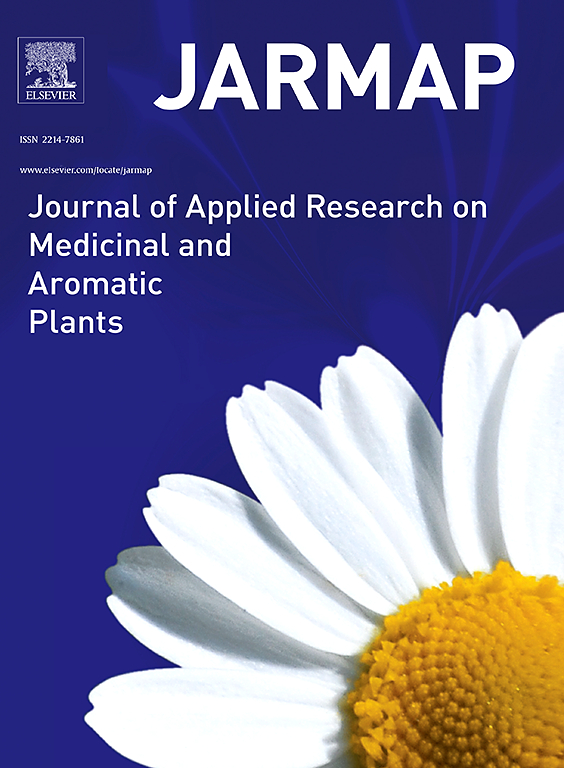延胡索块茎中异喹啉类生物碱的大小依赖性多样性和积累
IF 3.6
2区 农林科学
Q1 PLANT SCIENCES
Journal of Applied Research on Medicinal and Aromatic Plants
Pub Date : 2025-09-01
DOI:10.1016/j.jarmap.2025.100660
引用次数: 0
摘要
延胡索是一种传统的镇痛中药,生物碱是其主要活性成分和质量标志。市场上可买到的延胡索质量参差不齐,通常按块茎大小分类。然而,不同大小的块茎质量是否不同,以及这种差异背后的分子机制尚不清楚。因此,我们旨在利用综合代谢组学和转录组学分析来研究延胡索块茎大小与生物碱积累的关系。对3种不同大小的延胡索块茎进行了代谢组学和转录组学分析。差异生物碱谱与基因表达模式相关,并使用脱落酸(ABA)处理来评估转录因子的反应。小块茎的总生物碱含量高于大块茎。靶代谢组学分析共发现481种生物碱,主要为异喹烷类生物碱(41.58 %),多数在小块茎中含量高于大块茎。结合转录组数据,我们的研究结果表明,不同大小的块茎中生物碱的积累可能与环境适应和块茎生长发育之间的权衡有关。NAC、C3H、GRAS等核心转录因子对50 μM ABA有响应,可能调控了C. yanhusuo的生长发育。这种调节可能导致不同大小块茎中生物碱含量和形态的差异。本研究为提高盐狐索的利用水平提供了参考,并为今后的分子育种提供了科学的见解。本文章由计算机程序翻译,如有差异,请以英文原文为准。
Size-dependent diversity and accumulation of isoquinoline alkaloids in Corydalis yanhusuo tubers
Corydalis yanhusuo is a traditional analgesic herb, with alkaloids as its primary active compounds and quality markers. The quality of C. yanhusuo available in the market varies considerably and is often classified by tuber size. However, whether quality differs among tubers of different sizes, and the molecular mechanisms underlying such differences, remains unclear. Hence, we aimed to investigate the relationship between tuber size and alkaloid accumulation in C. yanhusuo using integrated metabolomic and transcriptomic analyses. Targeted metabolomics and transcriptomic analyses were conducted on C. yanhusuo tubers of three different sizes. Differential alkaloid profiles and gene expression patterns were correlated, and abscisic acid (ABA) treatment was used to assess transcription factor responses. The total alkaloid content in small tubers was higher than that in large tubers. Targeted metabolomics analysis revealed 481 alkaloids, predominantly isoquinoline alkaloids (41.58 %), most of which were more abundant in small tubers than in large ones. Combined with transcriptome data, our findings suggested that alkaloid accumulation in differently sized tubers might be related to environmental adaptation and trade-offs between tuber growth and development. Core transcription factors, including NAC, C3H, and GRAS, which are responsive to 50 μM ABA, may regulate the growth and development of C. yanhusuo. This regulation may contribute to differences in alkaloid content and morphology among tubers of varying sizes. Our study provides a reference for improved utilization of C. yanhusuo and offers scientific insights for future molecular breeding.
求助全文
通过发布文献求助,成功后即可免费获取论文全文。
去求助
来源期刊

Journal of Applied Research on Medicinal and Aromatic Plants
Pharmacology, Toxicology and Pharmaceutics-Drug Discovery
CiteScore
6.40
自引率
7.70%
发文量
80
审稿时长
41 days
期刊介绍:
JARMAP is a peer reviewed and multidisciplinary communication platform, covering all aspects of the raw material supply chain of medicinal and aromatic plants. JARMAP aims to improve production of tailor made commodities by addressing the various requirements of manufacturers of herbal medicines, herbal teas, seasoning herbs, food and feed supplements and cosmetics. JARMAP covers research on genetic resources, breeding, wild-collection, domestication, propagation, cultivation, phytopathology and plant protection, mechanization, conservation, processing, quality assurance, analytics and economics. JARMAP publishes reviews, original research articles and short communications related to research.
 求助内容:
求助内容: 应助结果提醒方式:
应助结果提醒方式:


